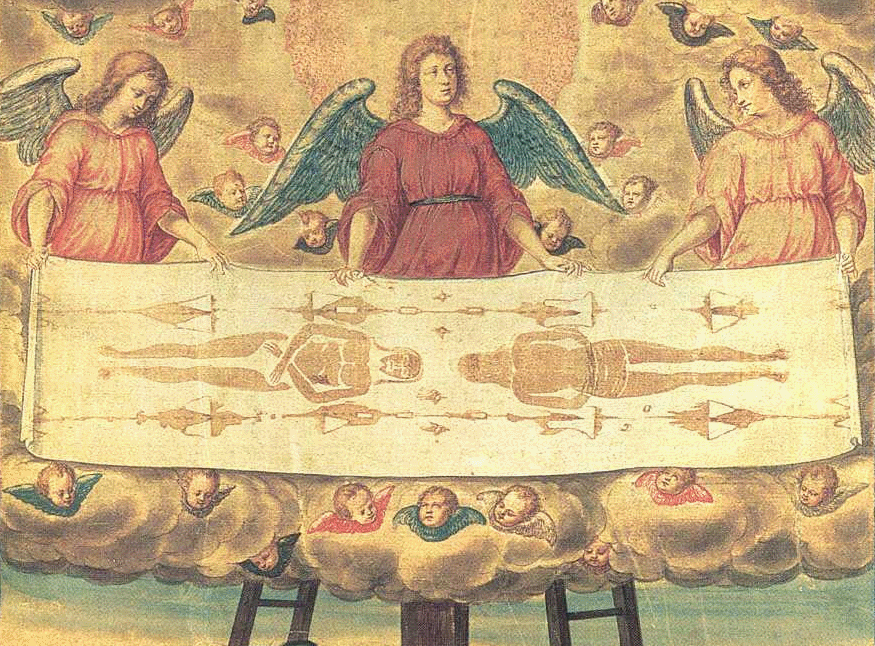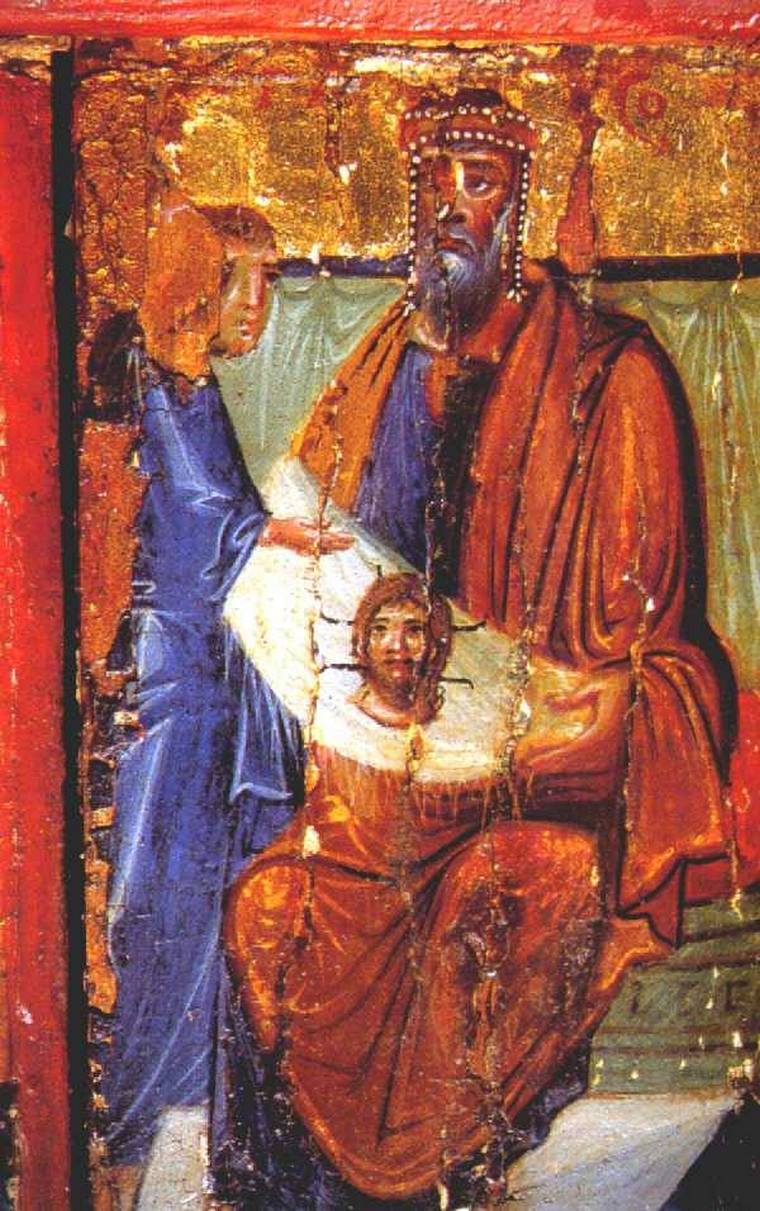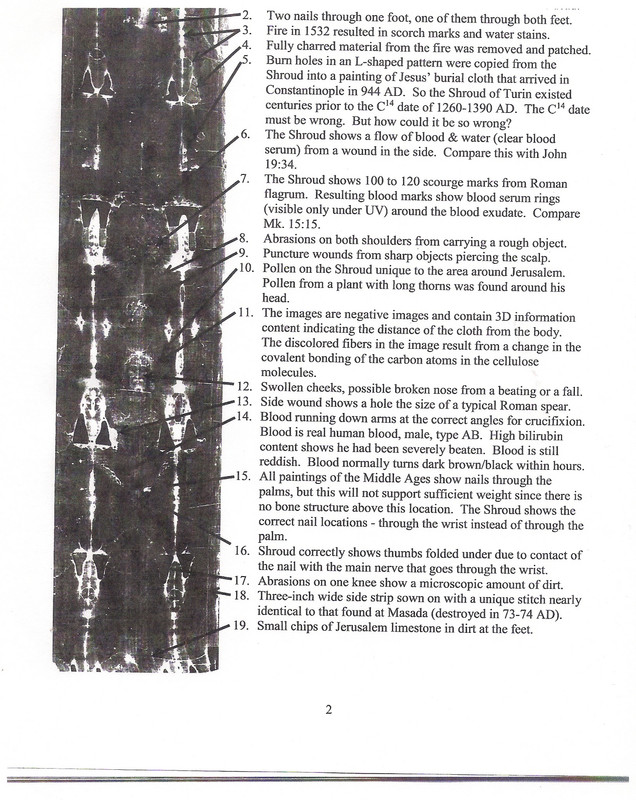
Posted on 04/10/2020 6:18:02 AM PDT by Antoninus

Today being Good Friday for Christians around the world, it is a fitting time to look at one of the most enigmatic and widely debated relics of history: The Shroud of Turin. While there have been no end of scientific attempts to determine what this fascinating image might be and how it was made, I find the historical attempts to trace its provenance to be more interesting.
The earliest reference to a shroud associated with Jesus may be found in Sacred Scripture. In the Gospel of Saint John we find the following passage:
"Then cometh Simon Peter, following him, and went into the sepulcher, and saw the linen cloths lying, And the napkin that had been about his head, not lying with the linen cloths, but apart, wrapped up into one place. Then that other disciple also went in, who came first to the sepulcher: and he saw, and believed. For as yet they knew not the scripture, that he must rise again from the dead." [John 20:6-9]
The question has been: what did the other unnamed disciple (traditionally Saint John himself) see to make him immediately believe? Of course, as evidence of the Shroud of Turin, this passage is cryptic at best.
A 10th century painting of Abgar V of Edessa receiving the Image.
Some investigators, foremost among them, Ian Wilson in his book The Blood and the Shroud, have attempted to explain what happened to this linen cloth. They link the burial cloth with the fabled Image of Edessa (also called the Mandylion of Edessa), a likeness of Jesus that purportedly protected the city of Edessa from attack for nearly 600 years. As the theory goes, the image was brought to King Abgar V of Edessa who had requested that Jesus come to visit him and cure him of a disease. It was borne by one of the disciples—Addai or Thaddæus—along with a letter from Jesus himself. The account of this visit was recorded in the early 4th century in Eusebius's Ecclesiastical History:
“Now, when they were come up, his princes happened to be standing there. And immediately, as he was entering in, a great vision appeared to Abgar on the countenance of Thaddæus the apostle. And, when Abgar saw Thaddæus, he prostrated himself before him. And astonishment seized upon all who were standing there: for they had not themselves seen that vision, which appeared to Abgar alone."
Eusebius's account also includes the supposed letter from Jesus to Abgar which was declared apocryphal by later Church authority. Eusebius claims, however, that he had seen the original documents himself, saying: "There is, however, nothing to prevent our hearing the very letters themselves, which have been taken by us from the archives, and are in words to this effect, translated from Aramaic into Greek." There is, however, in Eusebius's account, no direct mention of the famous image.
In AD 544, Edessa was attacked by the Persians. A generation later, an account of the siege was recorded by the historian Evagrius Scholasticus. His Ecclesiastical History contains the first mention of the Image of Edessa protecting the city from attack. The Persians had built a siege ramp against the walls. In an attempt to collapse the ramp, the Edessenes dug a mine beneath it and filled the cavity with wood and combustibles:
Click for more info.
"The mine was completed; but they failed in attempting to fire the wood, because the fire, having no exit whence it could obtain a supply of air, was unable to take hold of it. In this state of utter perplexity, they bring the divinely wrought image, which the hands of men did not form, but Christ our God sent to Abgarus on his desiring to see Him. Accordingly, having introduced this holy image into the mine, and washed it over with water, they sprinkled some upon the timber; and the divine power forthwith being present to the faith of those who had so done, the result was accomplished which had previously been impossible: for the timber immediately caught the flame, and being in an instant reduced to cinders, communicated with that above, and the fire spread in all directions. [The Ecclesiastical History of Evagrius, Book IV, Chapter XXVII]
Interestingly, Evagrius links the "divinely wrought image" directly to King Abgar.
A Medieval miniature showing the Image of Edessa arriving in Constantinople.
Later, so the theory goes, the Image of Edessa was brought to Constantinople. In a sermon commemorating this event in AD 944, the archdeacon of Hagia Sophia, Gregory Referendarius gives a very detailed account of the Image's history. He also gives a description of the image which seems, perhaps not coincidentally, to have a certain affinity to the appearance of the Shroud of Turin:
"For this is not the art of painting, which provides a door for the mind to consider the original and depicts images. This reflection was imprinted from a living original....This reflection...has been imprinted only by the sweat from the face of the originator of life, falling like drops of blood, and by the finger of God. For these are the beauties that have made up the true imprint of Christ, since after the drops fell, it was embellished by drops from his own side. Both are highly instructive – blood and water there, here sweat and image." [The Sermon of Gregory Referendarius, as translated by Mark Guscin]
The image on the Shroud as it exists today.
Finally, in AD 1204, the city of Constantinople was taken and sacked by the rogue armies of the Fourth Crusade. A French knight, Robert of Clari, participated in the sack and later wrote a chronicle. In it, he records what he saw in the ancient Church of Saint Mary in the Blachernae section of Constantinople:
But among the rest, there was also another of the minsters, which was called the Church of my Lady Saint Mary of Blachernae, within which was the shroud wherein Our Lord was wrapped. And on every Friday that shroud did raise itself upright, so that the form of Our Lord could clearly be seen. And none knows – neither Greek nor Frank – what became of that shroud when the city was taken. [Robert of Clari's Chronicle of the Fourth Crusade, Chapter 93]
Click for more info.
While these tid-bits do not provide a complete, authentic provenance for the Shroud of Turin stretching back to ancient times, they are nonetheless tantalizing clues for the historian. As many times as skeptics try to bury the shroud as a forgery, the relic continues to raise itself up and provide an endless source of fascination for a modern world which considers the divine distant and the miraculous impossible.
For a much more filled-out version of the above provenance written in a compelling style that draws the reader in like a mystery novel, I highly recommend Ian Wilson's The Blood and the Shroud: New Evidence that the World's Most Sacred Relic is Real as mentioned above.
Catholic Ping!
Pretty sure they had no need of relics as they met the risen Lord in person shortly thereafter....
Those who meet the risen and ascended Lord still have no need of relics.
The RCC takes no position regarding the shroud.
A blessed Good Friday to you.
The Basilica of the Holy Cross in Jerusalem or Basilica di Santa Croce in Gerusalemme, (Latin: Basilica Sanctae Crucis in Hierusalem) is a Roman Catholic minor basilica and titular church in rione Esquilino, Rome, Italy. It is one of the Seven Pilgrim Churches of Rome.
According to tradition, the basilica was consecrated circa 325 to house the relics of the Passion of Jesus Christ brought to Rome from the Holy Land by Empress St. Helena, mother of Roman Emperor Constantine I. At that time, the Basilica’s floor was covered with soil from Jerusalem, thus acquiring the title in Hierusalem; it is not dedicated to the Holy Cross which is in Jerusalem, but the Basilica itself is “in Jerusalem” in the sense that a “piece” of Jerusalem was moved to Rome for its foundation.
There are many important relics in this church, but the most moving is a full-size computerized reproduction of the Shroud. It is impossible to stand before it without being deeply moved. Every detail is there and it can be observed from very close up. I have a photo of it in remembrance.
Also in this church are pieces of the True Cross, a piece of the Cross of the Good Thief, nails from the True Cross, and the forefinger of St. Thomas, which he placed in the wounds of Jesus. There are also thorns from the crown Jesus wore.
ping
The evidence is overwhelming that the Shroud of Turin is the image of a resurrecting Jesus. True, no Christian needs to believe this, but any Christian ought to be joyfully grateful with this special gift from God, which only could be correctly interpreted in the past century or so.
At the very least, the study of the Shroud is one of the most fascinating subjects anyone could want to do.The Shroud implicates so many areas of human existence: history, art, religion, science etc.
The best site on the Shroud I have found is run by a man in Australia:
https://theshroudofturin.blogspot.com/
The site requires some effort to navigate, but there are many rewarding insights to be found there. The site is scrupulous and meticulous, and above all it is reasonable. Well worth a bookmark and leisurely browsing.
Ping
TY!

If you want on or off the Shroud of Turin Ping List, Freepmail me.
No, I think it was because they saw Him in person.
Awesome. If I’m not on that ping list already, please add me.

Perhaps it was the reality that the wrappings lay where the body had been and they were empty but had not been unwrapped? Yet the wrapping for The Lord’s Head lay apart from the still bundled body wrappings? Or may, just maybe, the Holy Spirit stamped the reality upon their consciousness indelibly.
I have been pondering the way the image was caused ... and I do believe the image is of my Lord when His soul and Spirit took up a body again, a glorified body whose space and time coordinates are not the same as we sense now. BTW, in the snatching away departure of the Body of Christ growing sine the day of Pentecost, when He comes for us we will be instantly changed into the same as He is now, and the things we are wearing in that instant will also register an image in our departure. When He appears, we shall see Him as He is now, for we shall have been changed to be like Him.
Regeneration. That’s my belief.

Disclaimer: Opinions posted on Free Republic are those of the individual posters and do not necessarily represent the opinion of Free Republic or its management. All materials posted herein are protected by copyright law and the exemption for fair use of copyrighted works.